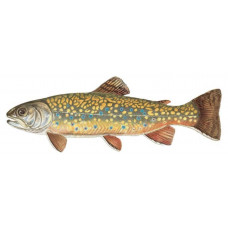Latin name
Salvelinus fontinalis
Other names
Eastern brook trout, speckled trout, native, spotted trout, speckled charr, brook charr, salter, coaster, squaretail, brookie, aurora trout, mountain trout; French: truite mouchetée.
Identification
Brook trout have such unique coloration and patterns that they are rarely confused with other fish, especially if you have a native specimen (which will have a richer and more vibrant coloration than a hatchery specimen). Three external characteristics will immediately distinguish brook trout from brown trout, rainbow trout, or other charr species. White stripes on the outer edges of all fins except the tail fin identify them as charr. A narrow black stripe runs along the inside of the white fin edges. The spots on the body of true trout are on a light background, but all char have them reversed. Trout have large scales that are easily visible to the eye, while char have very small scales. A completely unique feature of brook trout is the worm-like wavy lines, called vermiculations, on the back and head. They appear as a series of tiger stripes on the dorsal, fat, and tail fins. Like all salmonids, brook trout have a rudimentary fat fin on the back. It also has paired pectoral and pelvic fins and a single anal fin just behind the belly. Coloration can vary greatly depending on the environment, ranging from a light metallic blue in fish caught in salt water (called salt marshes) or in fish that leave their native streams and spend part of the year in large, deep, clear lakes (called shorelines), to dark brown and yellowish bodies in trout trapped behind beaver dams or in high mountain ponds. In both sexes, body color intensifies during spawning and is more pronounced in males.
Distribution
Brook trout populations still exist throughout much of the species' original range. Their range includes the entire northeastern United States, the Canadian Maritime Islands, Labrador and Newfoundland, and they inhabit all the rivers and streams in Quebec and Ontario that flow into the Hudson and James Bays. The 96° longitude line, where it intersects with Minnesota, is the natural western limit of brook trout distribution in the United States, although they have been introduced elsewhere and as far away as California. The southernmost distribution of brook trout is in the headwaters of the Chattahoochee River in Georgia.
Habitat
Compared to all other char species, as well as salmon and trout, brook trout are the least demanding in terms of habitat. This allows them to live in a wide variety of environments with a wide range of tolerances. They live in small streams, creeks, brooks, and beaver ponds. They live in large streams and all types of lakes, from the Great Lakes to small lakes and ponds to small rivers and large rivers with violent waterfalls and rapids. Because of a unique organ (glomerulus) in their kidneys, they are anadromous and can migrate to river mouths and thrive in brackish tidal creeks, pure salt bays, and even the oceans themselves. However, they are a classic example of a cold-water species and do best in the northern half of the Northern Hemisphere.
Size
Brook trout are short-lived fish, usually surviving into their fourth or fifth year, although some individuals live to be at least 10 years old. In most areas, the average brook trout caught is 7 to 10 inches long and weighs well under a pound. Many shallow natural trout habitats do not have conditions conducive to reaching larger sizes. Brook trout over 12 inches are large fish in most northeastern reservoirs, and fish over 2 pounds are rare. However, the fish are capable of reaching larger sizes. A 14-pound, 8-ounce brook trout caught in 1916 is a world record for the species in any tackle; this individual was 31 inches long.
Life history and Behavior
Brook trout spawn in late fall and early winter. Immature and small adult brook trout are more likely to stay in a stream, even if there is a lake or pond nearby, because the stream habitat provides better protection from predators. During the summer months, the larger brook trout tend to live in the lake, where there is more food, and move to rivers or streams only to spawn. Some fish populations migrate to the ocean for short periods of time. They move up and down rivers in the spring or early summer, staying in estuaries and ocean areas where food is plentiful. After about 2 months, they return to freshwater. Not all fish in the population migrate and not all migrate every year. Sea-run brook trout live longer and grow larger than freshwater brook trout.
Food and feeding habits
Brook trout 4 to 8 inches long feed primarily on aquatic and terrestrial insects. Between 8 and 12 inches, they begin to feed on small fish. Large trout, especially in northern waters in the summer, have been known to eat small mammals (mice, voles, shrews, and lemmings) that enter the water.
Reproduction
No information
| Classification | |
| Phylum | Chordata |
| Class | Actinopterygii |
| Squad | Salmoniformes |
| Family | Salmonidae |
| Genus | Salvelinus |
| Species | S. fontinalis |
| Features | |
| Conservation status | Secure |
| Habitat | Pelagic |
| Life span, years | 15 |
| Maximum body weight, kg | 6.6 |
| Maximum length, cm | 86 |
| Sailing speed, m/s | No information |
| Threat to people | Edible |
| Way of eating | Predator |



